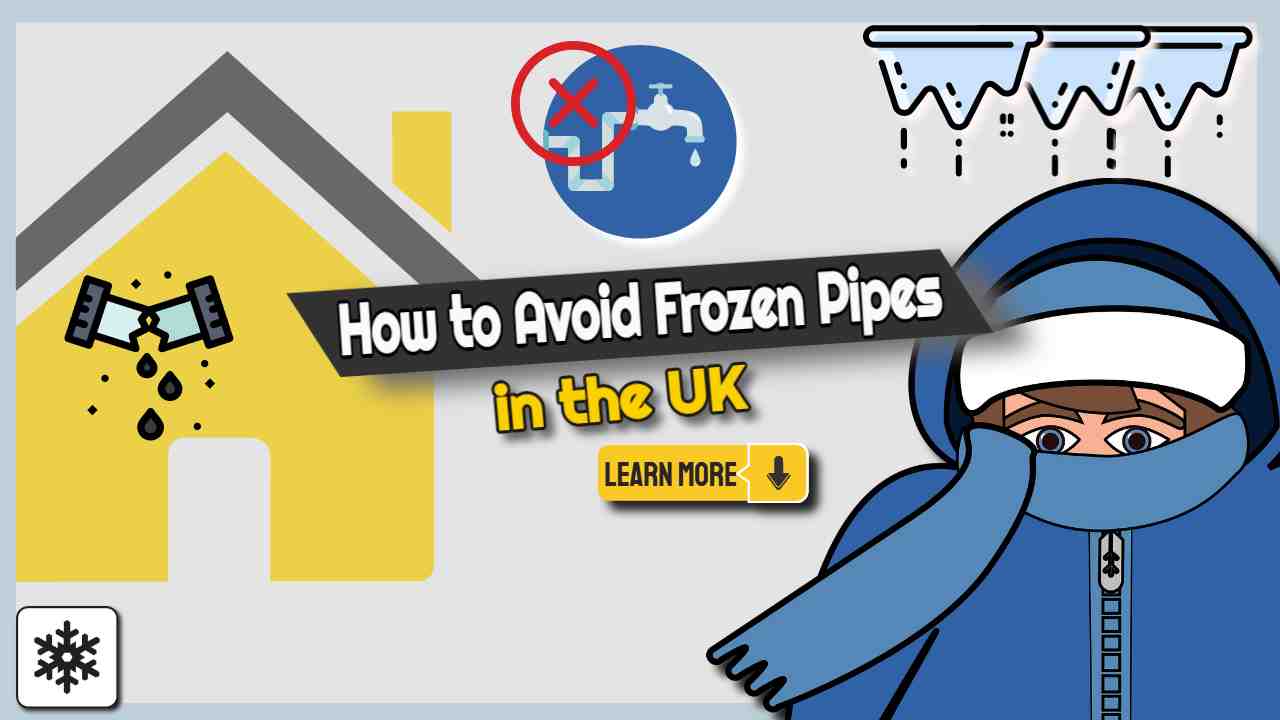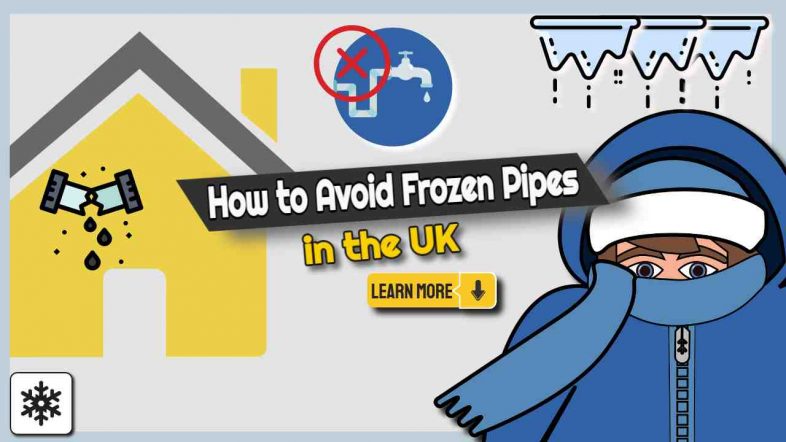Here are our tips on how to avoid frozen pipes, UK experience-based common-sense water damage prevention.
In extremely cold below zero temperatures, water in your unheated home may freeze. All pipes will ultimately freeze if the temperature continues below freezing for an extended length of time. Yes. Even if they are inside a residence. Without a source of heat, good insulation can only delay the occurrence of a pipe freeze-up.
Burst pipes are a problem because water expands when it freezes and turns to ice in a pipe. As the ice spreads, the tension on the pipes and couplings increases, causing them to shatter or split apart.
Cardinal Rule No. 1: How to Avoid Damage Frozen Pipes in the UK? Turn Off the Water at the Stopcock!
If you're going to be out of town for a few days or longer, turn off the water at the main cutoff. If frozen pipes do burst, the damage will be modest. Also, turn off your automatic icemaker so it doesn't continue to create ice. Even if the ice bin is full, the ice will slowly evaporate, and the ice maker will attempt to manufacture more.
Which Pipes More Susceptible to Freezing Than Others?
Kitchen plumbing frozen pipes, situated on external walls, are more common than elsewhere because they are frequently concealed behind closed doors (e.g. in cabinets). The warmth from the rest of the home cannot reach them in a cupboard. Simply open the cabinet doors before departing on a winter vacation. This will allow warmth to penetrate inside the kitchen cabinets.
Pipes on the inside of exterior walls tend to freeze first, followed by those on the inside of internal walls.
For homes/spaces without a heating system, a fan or portable electric heater can be plugged into one of those frost-stat equipped thermostat plugs, which are sold in most major DIY stores.

How to Avoid Frozen Pipes UK – Advice to Keep Pipes from Freezing
First, you must make the effort to find your water supply intake stopcock.
Everyone should be aware of where their stopcock is. You don't want to be frantically searching for it while your house is flooded and you don't know how to stop it!
It is frequently located on the ground floor, behind a sink, near the stairs, or near the gas metre.
Again, it's a good idea to leave cabinet doors beneath the kitchen sink and bathroom cabinets open to enable warm air to circulate around pipes that are exposed to the elements or are connected to the outside walls.
Turn on the taps to see which pipes in your home transport water and which carry gas. If it vibrates or makes a sound while the water is running, it is a water pipe.
Leave Heating Systems on the Frost Protection Setting
To prevent your pipes from freezing and burst, make sure they are not exposed to temperatures below the danger threshold of 32 degrees Fahrenheit (O°C). Most heating systems may be configured to start up and keep the rooms slightly above a pipe freezing hazard temperature without being turned off.
For most homes, this is a low-cost solution that may save you a lot of trouble by keeping your pipes from freezing while you're away.
This is how to prevent pipes in an empty vacation house from freezing. After using the frost-stat setting, make sure to reset the thermostat to “auto” when you return.
Heating Systems Which are Fuelled by Oil or LPG Gas – How to Avoid Frozen Pipes UK
If your boiler runs on oil or LPG gas, ensure you have enough fuel to keep your house warm during the winter and while you are away.
You don't want to run out of supplies just to find out that your supplier is unable to deliver due to the harsh winter weather. If you run out of oil, turn off the water at the mains stopcock and empty the system. This should protect pipes from freezing throughout the winter.
How to Prevent Pool Pipes from Freezing UK
Drain the water from the pool and any garden sprinkler supply lines as directed by the manufacturer or installation contractor. Do not use antifreeze in these lines unless otherwise stated. Antifreeze is environmentally harmful and can harm humans, pets, animals, and the broader landscape.
Where can I find the location of my internal stop tap?
Where can I find the position of my internal stop tap so that I may turn off my water in an emergency?
Under the kitchen sink is the most commonplace for stop taps. Another location will be where your house's water supply line joins to the main water supply pipe outside your property.
Your stop cock on the street or at the edge of your property is nearly usually hidden, and homeowners and residents rarely utilise this valve. It is solely used by your water company.
If you can't find your stopcock under the sink, look around your house for other water appliances, sinks, toilets, and other plumbing fixtures.
If All Fails and You have a Pipe Burst
In the event of a pipe break, getting to the main stopcock and closing the valve as soon as possible might be the difference between life and death. It is worth the time to ensure that you know where your internal stop tap is and that it is working, as you may use it in an emergency, such as a burst pipe.
Additional Tips for Preventing Pipe Bursts
To keep the water from freezing in the winter, flush the toilets and sprinkle one or more spoonfuls of salt down the toilet or sink.
We propose that you use a foam tube known as “lagging” to cover all of your water lines, including those outside your house. A low-cost, easy-to-install option that can be obtained for less than £3 at most DIY stores. Keep in mind that any pipes that will be exposed to the weather should be insulated with waterproof lagging.
How to Keep Your Garage Pipes From Freezing
If your garage has water pipes and no continuous heating, you should insulate them and if you won't be running water through them almost constantly they are best drained. If you don't want to drain the pipes in unheated rooms and garages as you wish to use them in winter there is a solution. Ask your professional plumber, such as your trusted Glasgow southside plumber, to quote for pipe insulation plus trace heating.
Trace heating is a type of frost prevention where an electrician fits an electric cable with known resistance to current flow and wraps the cable around the pipe inside the lagging. The result is a warm electric cable which is fed with electricity at all times during cold weather.
Avoiding Frozen Pipes in the UK Applies to Water Supply Pipes Not Drains!
In the UK and Scotland (including Glasgow!) sewers and surface water drains are laid low in the ground, where the frost can't penetrate and they don't freeze.
Regardless of where you live, you just need to be concerned with the water supply pipes, not the drain pipes. But how do you tell which one is which?
Water pipes have a diameter of around 2.5 cm (1 inch) or less. Drain pipes are often made of plastic and terracotta. They have a diameter of 7 cm (3.5 inches) or greater.
Because drain pipes do not hold water (it just runs straight through) and are not pressurised like water pipes, freezing is not a concern in the UK.
Be Ready for Winter Weather Every Autumn!
Inspect taps, pipes, cold water tanks, and appliances visually for the start of any leaks on a regular basis. Water leak indicators should not ever be ignored. That's because small leaks left unchecked will very often soon become bigger leaks.
Leaking and burst pipes cause severe damage to property. All leaks, anywhere in your plumbing, should be repaired as soon as feasible after they are found.
Watch Out for Holes and Cracks in Walls Near Pipes
Wind chill also adds to pipe freezing. If a pipe is near a wall opening of any sort make sure that there is no opportunity for cold air flowing past a water pipe to freeze that pipe really much quicker.
Ice production is increased in unheated places with cracks, fractures, or gaps that allow cold, outside air to blow in.
Even modest breaches, such as the little holes that allow internet, telephone leads, cable, or television aerial lines to enter a room, are a danger for freezing. They can allow a dangerous amount of cold air to enter a structure in very cold and wintery high winds.



